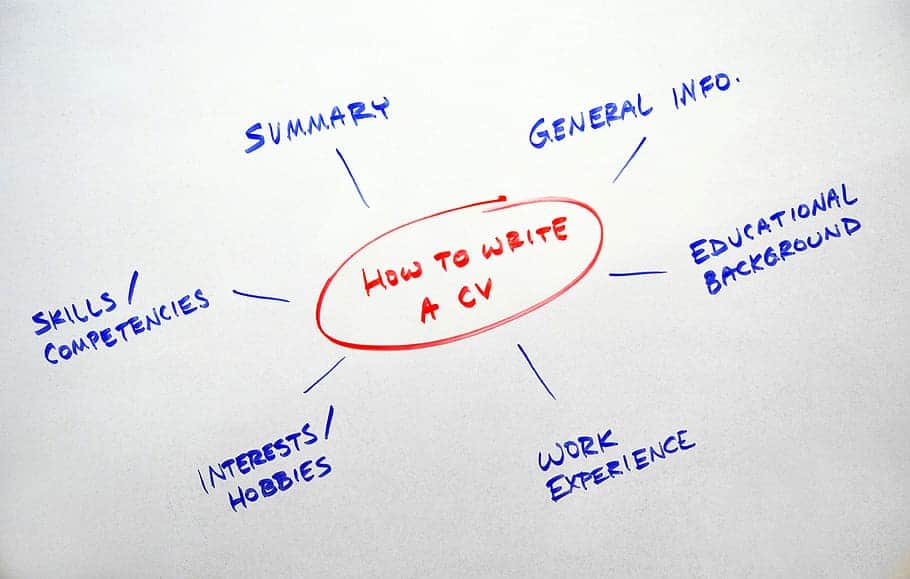Featured image by Mohamed Hassan
The terms curriculum vitae (CV) and resume are often used interchangeably. So, it’s easy to think that these documents are the same. However, in fact, they’re not.
But, they are quite similar and hard to distinguish unless you know the difference. Knowing the difference is essential because sometimes your entire future career may depend on how accurately you choose the type and format of your job application document. So, let’s dive into the topic. In this article, we’ll explain:
- What a CV is.
- What a resume is.
- How a CV and resume differ.
- How to pick which one to use.
When we’re finished, you’ll know everything you need to apply for your dream job and really get noticed.

What Is a CV?
CV stands for “curriculum vitae”, Latin for “course of life”. As the name implies, this is a long document. It’s typically, 2-3 pages long, or even longer. This in-depth document describes a person’s full career course in full detail. It also provides comprehensive information about:
- Education
- Research
- Publications
- Grants
- Skills
A CV also typically contains a short summary at the top of its first page and is usually accompanied by a cover letter unless required otherwise. It can be quite difficult to write a CV due to its length, level of detail, and strict formatting requirements. So, sometimes it can be best for an applicant to hire a professional writer to handle this daunting task in such a case one can turn to Skillhub.
What Is a Resume?
The word “resume” originates from French (résumé) where it stands for “summary”. This document is a condensed version of a CV. A resume is typically one to two pages long. It only contains the most important and relevant data about the applicant’s work experience, skills, education, training, and accomplishments.
There are a number of popular resume formats, each focusing on either work history, skills, or accomplishments. The most common types are:
- Chronological (or reverse chronological). The most widely accepted type focusing on work experience.
- Functional. Another popular format used to highlight one’s skills and qualifications over work experience.
- Combination. A fine blend of both chronological and functional types. it underscores skills and accomplishments, but gives a full overview of employment history as well.
A resume may seem easier to write than a CV, but this is not always the case due to the multiple ways the information can be structured. If you’re unsure if you can make the most of your skills and experience in one short document, there are resume writing services ready to help.
What’s the Difference?
Length
A CV is much longer than a resume. It’s typically, three or more pages long, whereas a resume is around two pages.
Level of Detail
A CV is more detailed. It should contain full comprehensive information about education, publications, research, and grants, as well as work experience and skills.
Format
Curriculum vitae has strict formatting requirements: information is structured in reverse chronological order only. A resume can be formatted in a variety of ways. It’s possible to highlight the most relevant data to get the recruiter’s attention.
Purpose
There are certain situations where a curriculum vitae is a preferable choice, and sometimes it’s better to choose a resume instead. The choice depends on the job description, location, specific career field, or even specific positions. Read more about that in the next section.
RELATED ARTICLE: 7 WAYS TO BOOST YOUR ONLINE HIRING PROCESS
How to Choose One
Now that you know the differences between the two documents, it’s time to learn how to choose between them.
The first, and most obvious, factor that influences the choice of the document type you should use is the job description. The exact demands are usually outlined there. Most recruiters specify whether you should send a CV or a resume and if you need a cover letter or not.
However, in some cases, job descriptions don’t help. Then, there are some common guidelines that will help you decide. If the type of document is not specified in the description, you should make your choice depending on the location and the industry, career field, and type of position.
Location
This factor really matters as each country has its preferences. In the US and Canada, a resume is the default format for most industries. While in the UK, Ireland, and most of Europe, recruiters usually ask for a CV. What is tricky is that the European curriculum vitae format is not very different from an American resume.
In Germany, the main job application document is called Lebenslauf (equivalent for curriculum vitae). But, it’s only one of many papers that an applicant in Germany needs to land an interview.
In countries like Australia and New Zealand, the terms are used interchangeably and usually mean a short document equivalent to a resume used in the US.
In Asian countries like India or Bangladesh, the format is different altogether. There, recruiters usually require a paper called “biodata”. This document should contain lots of personal data such as marital status, ethnicity, salary, and more. If you’re applying for a job in Asia, clear out the details about the required application type with human resource managers.
Industry and Position
It’s also crucial to keep in mind the industry and job type when choosing between the two documents. A CV is the default choice in academia, and you’ll definitely need it if you apply for positions like professor, lecturer, researcher, etc. It’s also mandatory for those applying for grants.
As for other industries, a resume (or its equivalent) is usually preferable, unless specified otherwise.
Wrapping Up
Although the terms “CV” and “resume” are often used interchangeably, there are still quite a few differences between them. It’s not always easy to choose one. When you have any doubts, use the article above for reference. Bookmark for instant access!
RELATED ARTICLE: 7 MISTAKES STUDENTS MAKE DURING JOB INTERVIEWS

